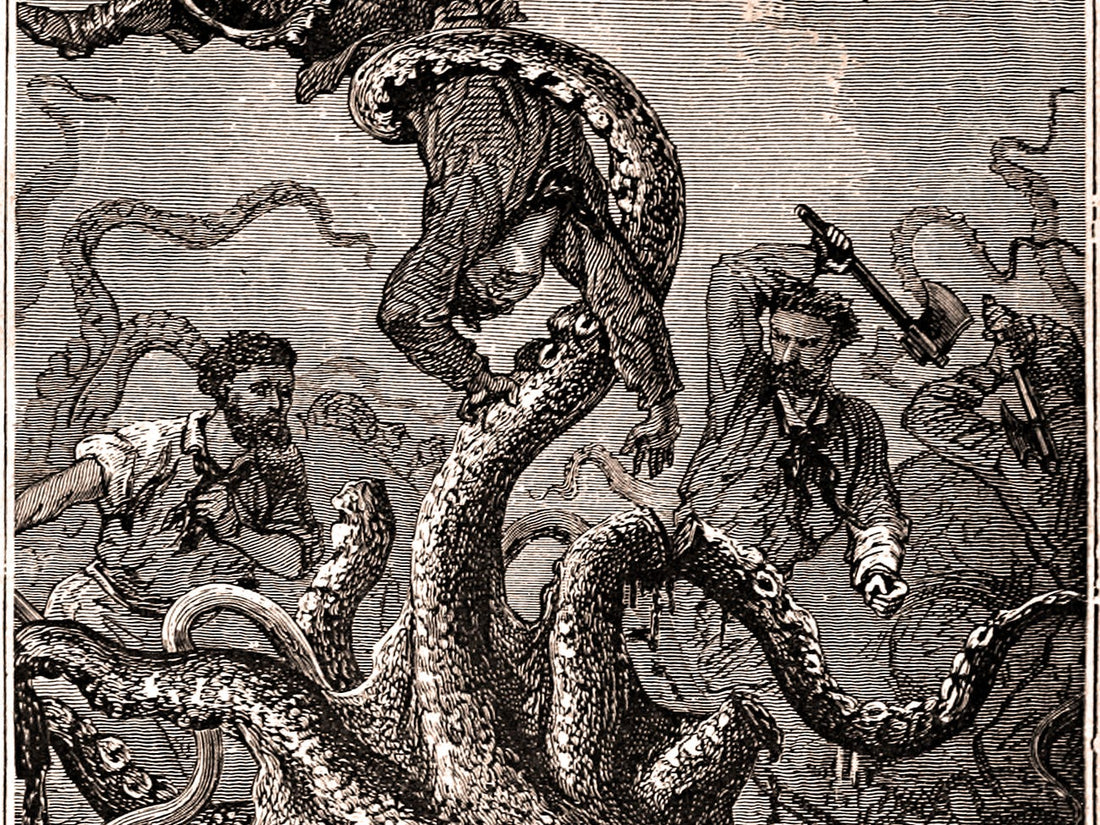Old maritime illustrations of the Kraken are fascinating and they inspired us to create our own Kraken artwork. This is what we learned about the Kraken.
What is the Kraken? A mythical sea monster feared by ancient sailors
- The myth of the Kraken has been written about for centuries by the earliest Scandinavian writers and many other seafarers around the world.
- Scandinavian sailors and fishermen believed the Kraken was a huge monster that appeared in certain sea conditions, especially in the summer.
- In Greek mythology, the Kraken was called the Scylla which was believed to live opposite another monster called the Charybdis.
- The Kraken is also known in Scandinavia as the Krake, Kraxen, Krabben, and Horven and is known in Greek mythology as the Scylla.
-
In Cornish folklore, a similar creature was called the Morgawr but was more often described as a sea serpent.
Buy my Kraken Art Print Poster in my shop
Historical descriptions of the Kraken
- The Nordic sailors and fishermen described the Kraken’s huge back appearing and then its huge arms which could reach out of the water as high as a warship’s masts.
- Some sailors described it as a colossal fish with huge arms, others described it as a huge cuttlefish.
- Another sailor described it as having a head that was twelve feet (4m) high!.
- Some described it as having light and dark green ribbed skin.
- One sailor reported that a Kraken attacked their ship seized three men with its huge suckered arms and pulled them into the sea.

- There are other reports of the Kraken’s huge tentacle-like arms reaching out of the water and wrapping around a whole ship.
- Tales were told of sailors surviving an attack by cutting off the Kraken’s tentacles with axes.

A page from The Naturalist's Library which documents sightings of the Kraken.
Where did people believe the Kraken lived?
- Sailors and fishermen who worked along the Norwegian coast believed in the Kraken and recorded many sightings of it in the seas of Scandinavia.
- The Kraken was reported to exist around the Shetland Isles and also off the eastern coast of Scotland.
- It was also described to have been seen around the African coast.
- In Greek mythology, the Kraken, or Scylla, lived in the Strait of Messina between Calabria and Sicily in Italy. The Strait of Messina has strong tidal currents and a natural whirlpool which may have been the origin of the Scylla myth.

This depiction of the Scylla is drawn as a woman with a tail and dog heads sprouting from her body and is painted on a red-figure bell-crater dating from 450–425 B.C.
Kraken Culture
The image of the Kraken remains popular in modern arts and musical culture. The Kraken has been featured in films such as The Clash of the Titans and Pirates of the Caribbean.
The Kraken, or Scylla, was characterised in Homer’s famous story The Odyssey where Odysseus encountered it on his travels.
Homer’s poem - Scylla
Translated by Elizabethan poet George Chapman.
The Kraken
A sonnet by Alfred Lord Tennyson – 1809-1892
Nelly's illustration of the Kraken
The header image on this page shows an illustration from the original edition of Twenty Thousand Leagues Under the Sea.
Go deeper
You can read more about the Kraken here:
Terrifying monsters from around the world, World History Encyclopedia, 2021. Available at: https://www.worldhistory.org/Scylla_and_Charybdis/.
Video, available at: https://www.youtube.com/watch?v=oYVkyp_7xQM
The Naturalist’s Library. Hamilton, Robert, M.D., FRSE (1839) Available at: https://www.biodiversitylibrary.org/item/60177#page/389/mode/1up
Homer, Odyssey. TUFTS University Online. Available at:
https://www.perseus.tufts.edu/hopper/text;jsessionid=0C3862DF72BDE338E6D62A24A49FEF27?doc=Perseus%3Atext%3A1999.01.0136%3Abook%3D12%3Acard%3D111
The Kraken by Alfred Lord Tennyson. Poets.org.
Available online at: https://poets.org/poem/kraken
Scylla image. Wikimedia.
https://commons.wikimedia.org/wiki/File:Scylla_Louvre_CA1341.jpg
Poet George Chapman. Poetry Foundation. Available online at: https://www.poetryfoundation.org/poets/george-chapman



